I have some thoughts on this as well. Some of wich I have posted on TFO and some I have shared in private conversations wtih you. I'll share another and this one came about in some emails sent between Bill Zovickian and myself. I am thinking that we keep hatchling tortoises way too hot. The recommendation that hatchlings be kept 80-85 ambient temp I think is right on par, but the 100+ basking spot is way, way too hot. As I have stated here before, I keep all my torts outside. My hatchlings never, well 99% never, bask in direct sunlight. If it were not for the occasional treat that I may toss in for them, they would never get direct full sunlight. In the morning they come to the edge of the tall grass, shrub or bush to catch indirect or partial sun. Durring this time they are in more shade than sun. At mid day they seen to go deeper in the tall grass, shrub or bush and recieve no sun at all. In the afternoon they will come to the edge of the vegitation once again, but never fully exposing themselves. I have noticed that with my leopards they will do this untill their about 5-7 inches. At that point they will become more brave or comfortable and actually bask in the full sun. I think in an indoor situation the amount of humidity is in direct corilation with the basking temps. The hotter the bask, the more humidity you need to combat it. The cooler the bask, the less humidity you need. Bill Z said that he had observed wild populations of tortoises acting in the same manner as what I have witnessed here at home. He also says that he doesnt provide full basking spots for his torts untill they are almost 7". He keeps all his hatchling tortoises except pyxis, on eucalyptus mulch, dry and only provides uva and b without heat. He also maintains them at 85 degrees. He also points out that after 7" he will provide basking spots but not all day as they will just tend to sit and bask. I am thinking that in the wild tortoises will heat themselves and start foraging and that action doesnt necissarily mean they are in full sun all day either. In captivity, there is really no need for tortoises to forage. Their food is on schedule or readily available so all they have to do is bask. Could it be that basking, however necissary for a tortoise is also addicting to them as well and this excessive basking is leading to them being exposed to unnecissary heat causing us to crank up the humidity to unnatural levels? Sorry for the rambling just some more off the wall jargin from yours truly
You are using an out of date browser. It may not display this or other websites correctly.
You should upgrade or use an alternative browser.
You should upgrade or use an alternative browser.
Pyramiding Debate Twixt EJ and AH
- Thread starter Balboa
- Start date
- Status
- Not open for further replies.
Madkins007 said:My question for Tom, NERD, and the other 'humidity/moisture/misting is the key' people (and I already know that you all agree that basic cares and diet are important as well) is the issue of bone density.
Andy H., whatever other opinions you may have of him or his other statements, does make an interesting point with his claim that pyramiding and poor bone density go hand in hand. He has some decent evidence with things like autopsies and X-rays of live animals.
Do you think the high humidity method addresses bone density or bone health? Or, is this not an issue?
To me the word pyramiding is synonymous with that porous-type bone. If you don't have pyramiding you won't have that porous bone either. There is nowhere for it to be. In other words, if you have a smooth shell, and the husbandry is correct as you noted above, then the underlying bone would have to be smooth too. It can't get porous and grow inward.
I'm seriously considering taking up Andy on his offer to pay for x-rays of my sulcata babies. I can certainly answer all of the questions on his questionnaire. Maybe I'll see if one of my vet friends can get it done at a discount. It would answer this question pretty easily.
onarock, I agree with you. I think that we keep our tortoises too hot. They need to have a minimum internal temperature in order to function properly and digest food, but it does not require 100 degrees to do so. I have said a million times from observing my tortoises outside and watching them run and hide when temps hit 85 that 100 is too warm, and this is even adults that I am talking about.
Others argue that it gets way hotter than that in the desert, but the question is - are they sitting in the heat and the sun? I don't think so. They are in their burrows.
Underground temperatures are more stable and I bet you dollars to donuts that it stays around 80 all the time in those big Sully burrows over there in Africa. During the day, the sand heats up but the burrow stays consistent because of how far underground it is. It might go up a few degrees, but not much, and at night, the sand releases the heat that it absorbed during the day again keeping the burrow consistent.
I have been keeping my baby Greek from the time I got her (August) at a consistent 82* with no basking spot, and she has tripled in size. She also is not pyramided, and I mist her once a day, and soak her every other day or so. I also don't overfeed her. She gets one meal a day that she can finish in 10-15 minutes. I wet down the substrate every week or so, and then let it dry back out over the course of the next week, as if it had rained (topsoil.) She has a little bitty burrow that she dug herself, and she spends a lot of time in there. When she comes out and starts really stomping around, it is because she is hungry, lol. And I have this smooth, gorgeous, active little rock hard baby.
My hatchling Redfoot is kept almost exactly the same way. 82* ambient temperature, no basking or hot spot. I spray him once a day, although I did start out spraying him (and the Greek too) a lot more in the first couple of months. He eats the same things my adults eat, greens, fruits etc. along with worms and fish. He doesn't have a burrow, but a flower pot turned on its side and covered and stuffed with moss. I think he was around 2 1/2" SCL when I got him (September,) and is now over 3 1/4". And perfectly smooth! His new growth is just smooth and shiny and perfect.
So, for those of you that would do things differently, what would you say I am doing "wrong" and why? My enclosures aren't as hot, and I don't keep them as wet, but I still have smooth, healthy tortoises. I believe that is because it absolutely IS a mixture of things. It has everything to do with food and temperature and exercise as much as it does humidity. And even though I have two different species from two totally different continents, my "formula" is working for both.
Others argue that it gets way hotter than that in the desert, but the question is - are they sitting in the heat and the sun? I don't think so. They are in their burrows.
Underground temperatures are more stable and I bet you dollars to donuts that it stays around 80 all the time in those big Sully burrows over there in Africa. During the day, the sand heats up but the burrow stays consistent because of how far underground it is. It might go up a few degrees, but not much, and at night, the sand releases the heat that it absorbed during the day again keeping the burrow consistent.
I have been keeping my baby Greek from the time I got her (August) at a consistent 82* with no basking spot, and she has tripled in size. She also is not pyramided, and I mist her once a day, and soak her every other day or so. I also don't overfeed her. She gets one meal a day that she can finish in 10-15 minutes. I wet down the substrate every week or so, and then let it dry back out over the course of the next week, as if it had rained (topsoil.) She has a little bitty burrow that she dug herself, and she spends a lot of time in there. When she comes out and starts really stomping around, it is because she is hungry, lol. And I have this smooth, gorgeous, active little rock hard baby.
My hatchling Redfoot is kept almost exactly the same way. 82* ambient temperature, no basking or hot spot. I spray him once a day, although I did start out spraying him (and the Greek too) a lot more in the first couple of months. He eats the same things my adults eat, greens, fruits etc. along with worms and fish. He doesn't have a burrow, but a flower pot turned on its side and covered and stuffed with moss. I think he was around 2 1/2" SCL when I got him (September,) and is now over 3 1/4". And perfectly smooth! His new growth is just smooth and shiny and perfect.
So, for those of you that would do things differently, what would you say I am doing "wrong" and why? My enclosures aren't as hot, and I don't keep them as wet, but I still have smooth, healthy tortoises. I believe that is because it absolutely IS a mixture of things. It has everything to do with food and temperature and exercise as much as it does humidity. And even though I have two different species from two totally different continents, my "formula" is working for both.
Paul, I don't know if this helps or hurts your argument, but whenever I have my herd outside, I check shell temps with my temp gun. On a warm day they will all be around 97-99. On a cool day they will still be mid-90's. The CDTs run just a little cooler at low to mid 90's, but they are only tiny hatchlings.
Also, I've seen people keeping their torts at the temps you mentioned and if its dry, they still pyramid, if its wet, like the outdoor ones in FL or New Orleans they don't.
Sounds like Bill keeps his in a similar manner to the Fifes. I'll be giving this a try with my next batch of sulcata hatchlings in May.
Also, I've seen people keeping their torts at the temps you mentioned and if its dry, they still pyramid, if its wet, like the outdoor ones in FL or New Orleans they don't.
Sounds like Bill keeps his in a similar manner to the Fifes. I'll be giving this a try with my next batch of sulcata hatchlings in May.
Kristina, I think your keeping is right on par with what I was thinking. I would like to see pics of your enclosures along with temp zones and humidity levels as I think they go hand in hand. With your method it sounds like soaking and spraying is more in line with what I would believe to be more "natural" and "realistic" conditions. Pics of those torts would be great also.
Very compelling argument Kristina. How well do you think it would work with "desert" species. I'm planning on trying what you are doing, but with sulcatas. I was planning on temps of 85-90 though.
I think it would work Tom. Part of the reason I want so bad to get my hands on a Sully or Leo baby, lol. I have been saying for years that my way would work, but until I got the two hatchlings I couldn't prove anything. Now I can  I just need a Sulcata or Leo to work with.
I just need a Sulcata or Leo to work with.
I have pics of both enclosures. I'll do a log of the humidity levels over a week so you can see how they change, and I will get some new pictures of the babies tonight (about time I showed them off again, anyway )
)
The temps are more or less constant throughout the entire enclosures. They are smaller aquariums so it is easier to heat them consistently, there is maybe a 2* difference from one side to the other.
Baby Greek -
The day I got her, for size references (I am holding her in both pictures.)
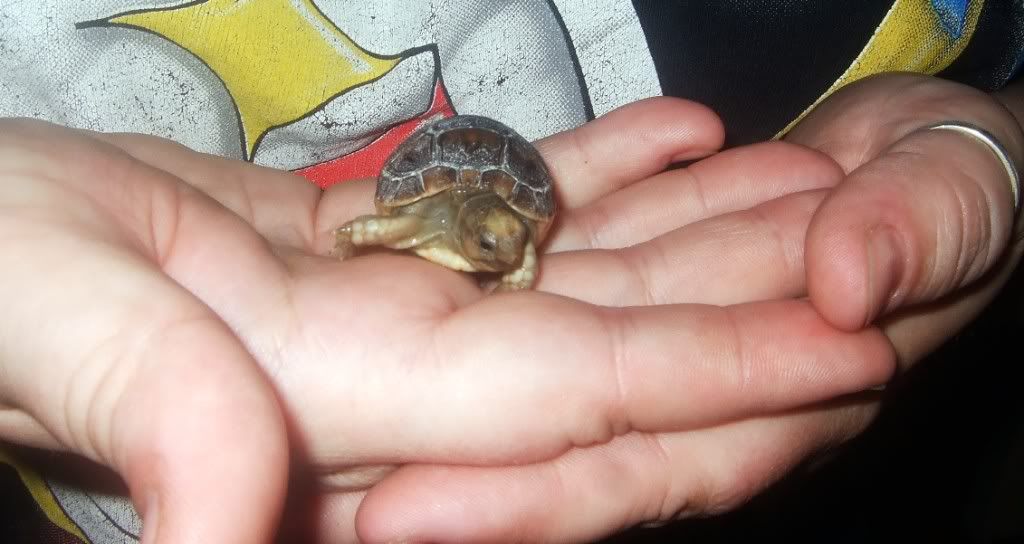
This picture is about a month old but shows her shell pretty well.
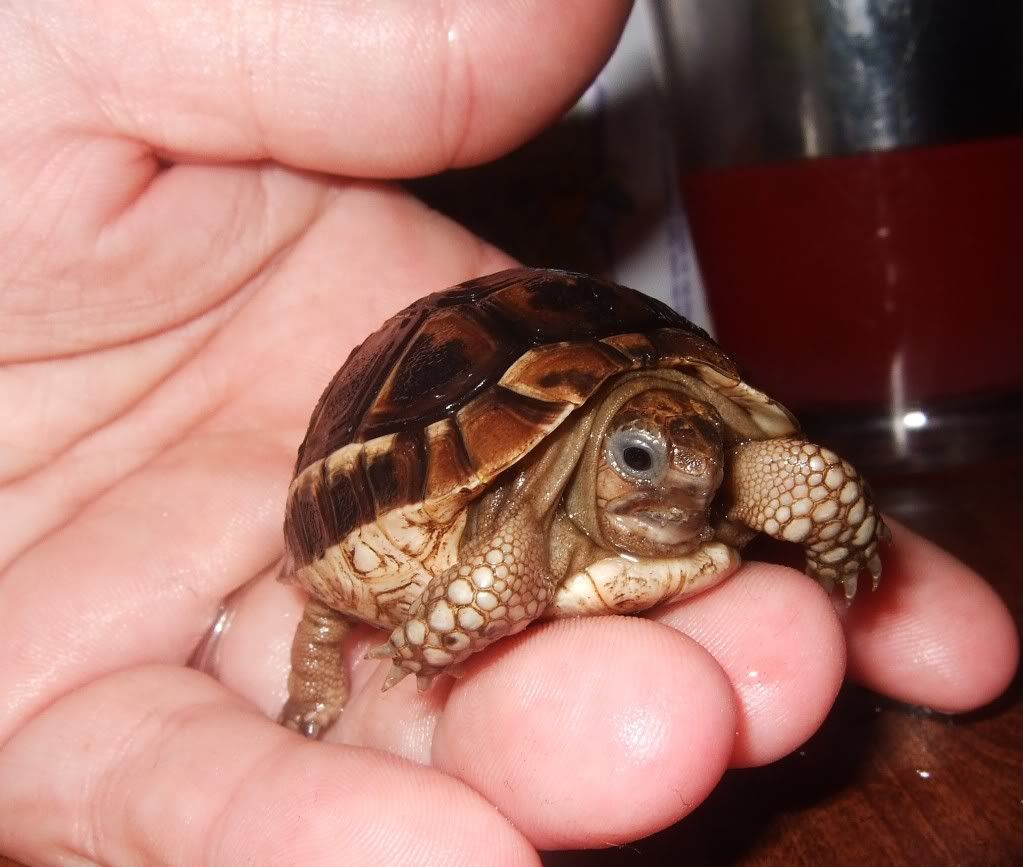
And another

Enclosure, 10 gallon aquarium
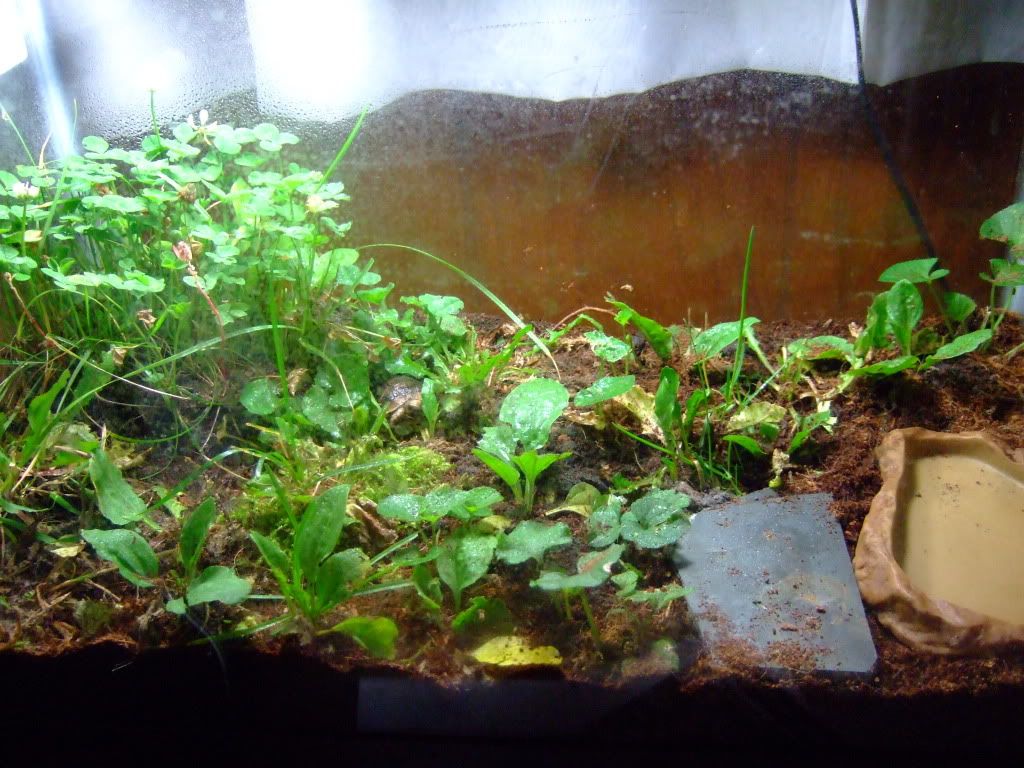
Coming out of her self-dug burrow
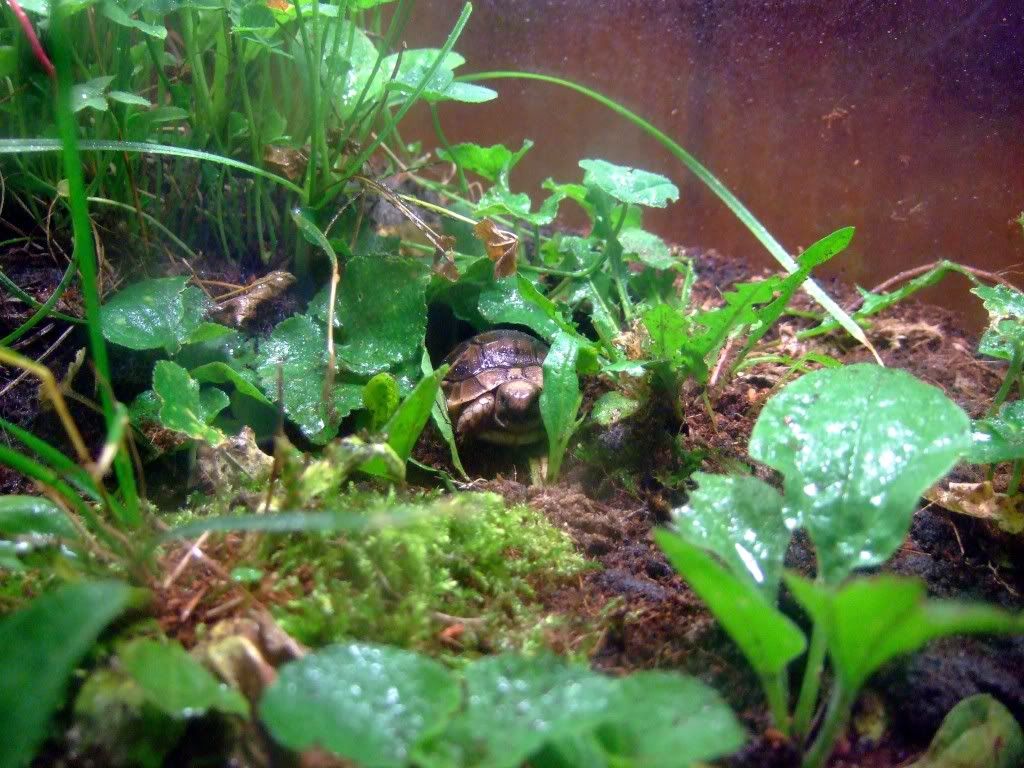
Baby Redfoot -
The day I got him
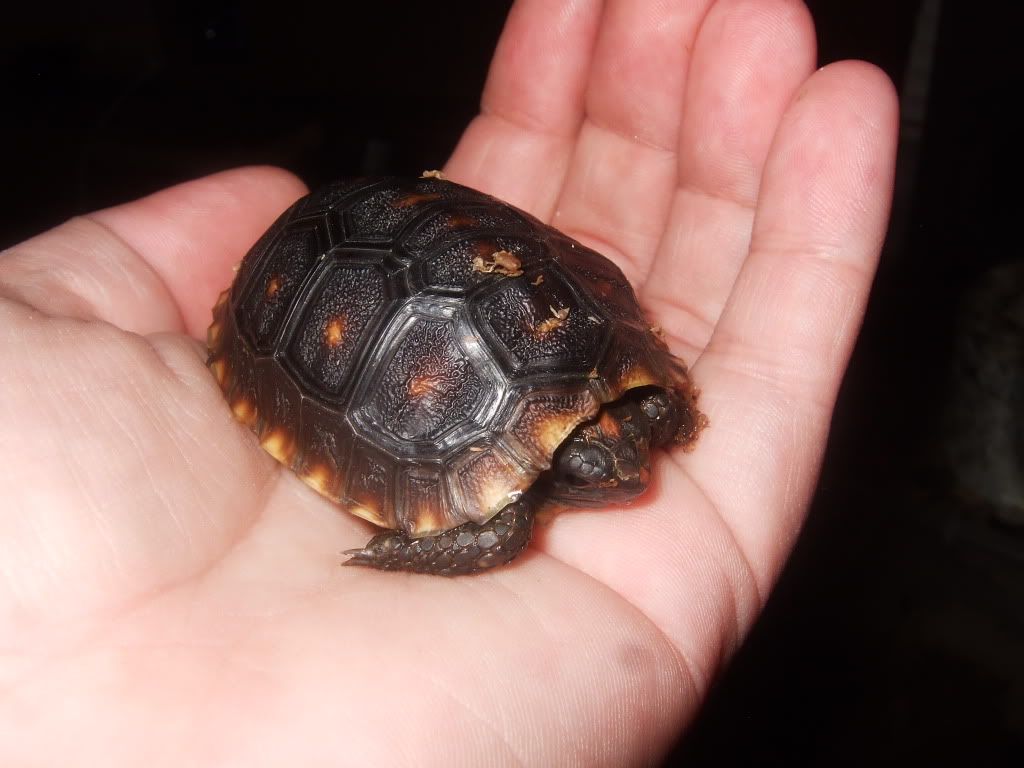
This picture is also about a month old

And a top view

Enclosure is a 20 gallon (slate bottom Metaframe) aquarium.
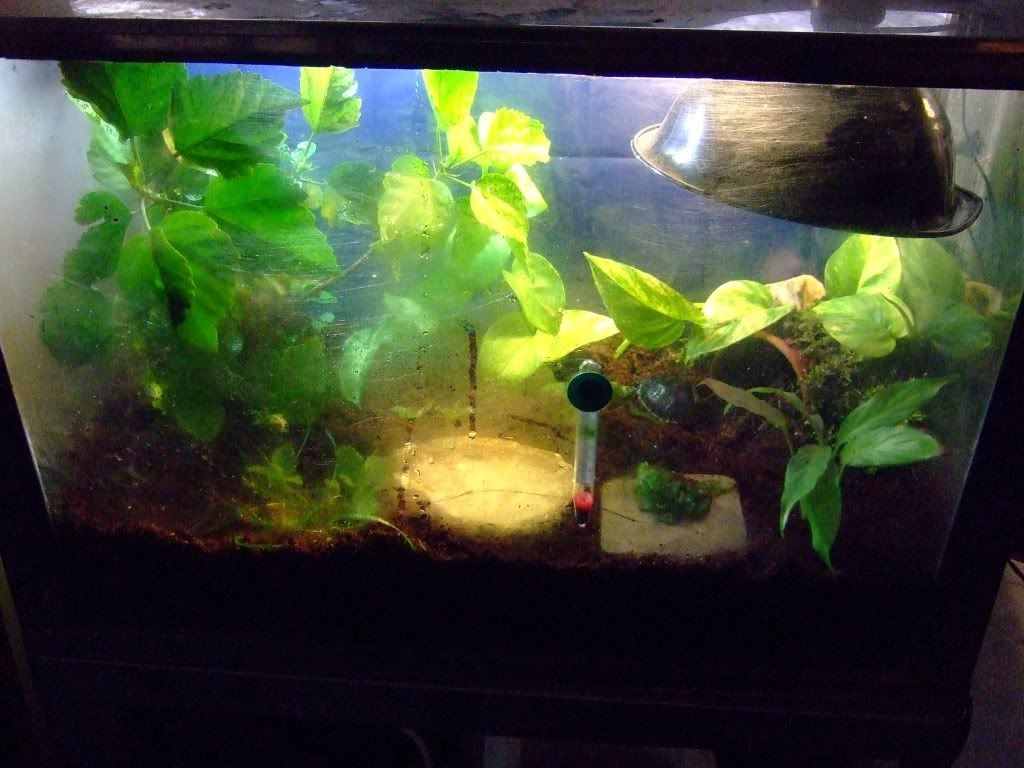
I have pics of both enclosures. I'll do a log of the humidity levels over a week so you can see how they change, and I will get some new pictures of the babies tonight (about time I showed them off again, anyway
The temps are more or less constant throughout the entire enclosures. They are smaller aquariums so it is easier to heat them consistently, there is maybe a 2* difference from one side to the other.
Baby Greek -
The day I got her, for size references (I am holding her in both pictures.)

This picture is about a month old but shows her shell pretty well.

And another

Enclosure, 10 gallon aquarium

Coming out of her self-dug burrow

Baby Redfoot -
The day I got him

This picture is also about a month old

And a top view

Enclosure is a 20 gallon (slate bottom Metaframe) aquarium.

I'll bet money that redfoot turns out to be female. Great looking enclosures. How do you heat them? I was going to just heat the whole room. I'd be happy to send you a couple of well started sulcata hatchlings this spring. She should be laying sometime in the next month. Of course I'll post it when she does.
Ha ha, you know, I say "he" but every time I have looked at the, um, identifying parts  I have thought female myself. Either way, it is so unique I wouldn't trade it for the world.
I have thought female myself. Either way, it is so unique I wouldn't trade it for the world.
The metaframe tank has a solid metal lid with two small vents. I covered the vents with mesh because of the little treefrog that also resides in there All the heat comes from a 75W incandescent black light bulb. The other lights do throw a bit of heat, but they are just 6500K GE CFLs so they don't get very warm at all. At night I have never seen it drop below 78*.
All the heat comes from a 75W incandescent black light bulb. The other lights do throw a bit of heat, but they are just 6500K GE CFLs so they don't get very warm at all. At night I have never seen it drop below 78*.
The 10 gallon has just a regular mesh terrarium lid that I covered with aluminum foil. The heat source is a 60W incandescent black light bulb. There are two CFLS in that aquarium also.
You all already know that I don't use UV lights, although I still cringe when I type it because I think ya'll might come after me with torches and pitchforks...
The new enclosures I am building are going to be 12' X 3' each, impervious to water and fully enclosed and insulated to make them easier/cheaper to heat consistently. I have also designed a mister system that will run on timers with the frequency of misting dictated by species. For daytime heating I will be using 100 watt swimming pool spotlights in exterior swivel fixtures (they will hold up better when the misters are on ) The hatchling enclosures will have the same components but be more the size of a 40 gallon breeder. I have been doing a LOT of research on different components and I am beyond excited to start this project.
) The hatchling enclosures will have the same components but be more the size of a 40 gallon breeder. I have been doing a LOT of research on different components and I am beyond excited to start this project.
I would love a couple of baby Sullies. I miss my big old Ella something terrible.
The metaframe tank has a solid metal lid with two small vents. I covered the vents with mesh because of the little treefrog that also resides in there
The 10 gallon has just a regular mesh terrarium lid that I covered with aluminum foil. The heat source is a 60W incandescent black light bulb. There are two CFLS in that aquarium also.
You all already know that I don't use UV lights, although I still cringe when I type it because I think ya'll might come after me with torches and pitchforks...
The new enclosures I am building are going to be 12' X 3' each, impervious to water and fully enclosed and insulated to make them easier/cheaper to heat consistently. I have also designed a mister system that will run on timers with the frequency of misting dictated by species. For daytime heating I will be using 100 watt swimming pool spotlights in exterior swivel fixtures (they will hold up better when the misters are on
I would love a couple of baby Sullies. I miss my big old Ella something terrible.
Well my concerns about basking are no secret. Sounds like a lot of us are keen on the idea of doing away with the things. The only thing that scares me about that is ensuring they are warm enough. There's a big question mark there for me.
I don't really see providing a bask as keeping the younguns too hot, I see it as providing a way for them to get hot enough when they need to. Now if they live under the thing, there's no doubt in my mind that's damaging.
I'm still trying to think of a way to provide heat gradients without dry spots.
I don't really see providing a bask as keeping the younguns too hot, I see it as providing a way for them to get hot enough when they need to. Now if they live under the thing, there's no doubt in my mind that's damaging.
I'm still trying to think of a way to provide heat gradients without dry spots.
About a year ago I posted some pictures of Pio on Andy's site, and attributed his smooth shell to high humidity.
Terry,
The diet you are using is excellent and I would not expect to see poor bone development or "pyramiding" on such a regime - regardless of environmental conditions.
On this topic of humidity affecting bone growth, there is NO serious scientific evidence for this whatsoever, and furthermore, the single piece of published "research" that those who promulgate such misinformation rely upon is deeply, deeply flawed. Let me put it this way. There are thousands of people (apparently) who believe that Adolph Hitler is still alive and was take to a secret base on the moon using flying saucers built by Nazi scientists ( ) They believe this passionately. Oh, and the moon is not airless - it has an atmosphere like Earth. NASA know this, but keep it secret so that "other countries" will not go there ( ). Everyone who disagrees is part of the great New World Order conspiracy or is simply a gullible fool. It is quite easy to get such nonsense accepted as fact, especially on the Internet where you have a lot of very vocal people spreading myths and "facts" they barely understand.
Fact: The biology of bone growth (and pathologies) is very well understood. Tortoises are no different than any other animal. The same rules apply.
Fact: Rapid growth is a key factor in all nutritionally related developmental bone pathologies.
Fact: Excess protein stimulates high growth rates.
If you control growth, and ensure adequate serum (blood) D3 and trace element levels the bone will develop correctly, at an optimum density. There will be no deformity. It cannot happen.
The whole "humidity" issue is a total red herring. It is unscientific, illogical, and unfortunately, leads many people to make fatal mistakes. Sadly, the good old Internet is the perfect place for such anti-science myths to spread like a nasty disease.
Andy
On the subject of UVB
The facts are that Redfoots (and Yellowfoots) obtain some preformed vitamin-D3 from animal protein, and the rest from UV-B. Their skin is very much more efficient at generating vitamin D-3 precursor than, say, a Testudo graeca or Leopard tortoise. For one thing, there are no horny, overlapping scales (which reflect large amounts of UV-B). Their skin is closer to that of say, a Green iguana than a Testudo graeca. So, although they live in environments where direct UV-B levels are lower than that found in semi-arid habitats, due partly to cloud cover, and moisture in the air which refracts UV-B, and also to their preference for forest-edge type habitats with extensive vegetation cover, they are easily able to generate sufficient D3 from much more limited exposure than would be required for a Leopard, Sulcata or Testudo graeca.
As always, this is a case of the tortoise being perfectly "designed" to optimise its performance in that specific habitat.
I should add that Kinixys erosa and Kinixys homeana both use exactly the same strategy/methods (and also have a very similar diet).
Andy
Terry,
The diet you are using is excellent and I would not expect to see poor bone development or "pyramiding" on such a regime - regardless of environmental conditions.
On this topic of humidity affecting bone growth, there is NO serious scientific evidence for this whatsoever, and furthermore, the single piece of published "research" that those who promulgate such misinformation rely upon is deeply, deeply flawed. Let me put it this way. There are thousands of people (apparently) who believe that Adolph Hitler is still alive and was take to a secret base on the moon using flying saucers built by Nazi scientists ( ) They believe this passionately. Oh, and the moon is not airless - it has an atmosphere like Earth. NASA know this, but keep it secret so that "other countries" will not go there ( ). Everyone who disagrees is part of the great New World Order conspiracy or is simply a gullible fool. It is quite easy to get such nonsense accepted as fact, especially on the Internet where you have a lot of very vocal people spreading myths and "facts" they barely understand.
Fact: The biology of bone growth (and pathologies) is very well understood. Tortoises are no different than any other animal. The same rules apply.
Fact: Rapid growth is a key factor in all nutritionally related developmental bone pathologies.
Fact: Excess protein stimulates high growth rates.
If you control growth, and ensure adequate serum (blood) D3 and trace element levels the bone will develop correctly, at an optimum density. There will be no deformity. It cannot happen.
The whole "humidity" issue is a total red herring. It is unscientific, illogical, and unfortunately, leads many people to make fatal mistakes. Sadly, the good old Internet is the perfect place for such anti-science myths to spread like a nasty disease.
Andy
On the subject of UVB
The facts are that Redfoots (and Yellowfoots) obtain some preformed vitamin-D3 from animal protein, and the rest from UV-B. Their skin is very much more efficient at generating vitamin D-3 precursor than, say, a Testudo graeca or Leopard tortoise. For one thing, there are no horny, overlapping scales (which reflect large amounts of UV-B). Their skin is closer to that of say, a Green iguana than a Testudo graeca. So, although they live in environments where direct UV-B levels are lower than that found in semi-arid habitats, due partly to cloud cover, and moisture in the air which refracts UV-B, and also to their preference for forest-edge type habitats with extensive vegetation cover, they are easily able to generate sufficient D3 from much more limited exposure than would be required for a Leopard, Sulcata or Testudo graeca.
As always, this is a case of the tortoise being perfectly "designed" to optimise its performance in that specific habitat.
I should add that Kinixys erosa and Kinixys homeana both use exactly the same strategy/methods (and also have a very similar diet).
Andy
Wow Terry that's very interesting to read.  Is this "Andy" the one you got Pio from?
Is this "Andy" the one you got Pio from?  Kind of saying the same thing as Danny was trying to say.
Kind of saying the same thing as Danny was trying to say. 
Can't say that I agree with Andy. I respect his experiance and knowledge,but I have to believe what I've seen. The scientific method boils down to "the results are..". The results I have seen are "humidity is the paramount factor in producing a smooth carapace.
I'm not typing up that whole rebuttal to Andy's ridiculous post again. I already did it the first time we saw this silliness. He has however gone back on these words, as evidenced in his recent excursion into the wild and what he wrote about it. He credited Ed P. with turning him around, if I'm not mistaken. Yvonne posted the info on this if I remember correctly.
Does Andy raise sulcatas or leopards? Does anyone have an Andy produced tortoise or picture of one? I'd be a little curious, I can't seem to find anything but my internet searching skills are not very good.
Good point Neal. How about we all look at this another way. Can anybody show me a smooth sulcata or leopard that THEY raised from a hatchling with out high humidity, moisture and hydration? CG Keith showed us a pretty nice yearling sulcata a while back.
I got one. Since I'm posting pics of her tonight like she was an adult entertainer. No heat, no extra humidity, basically no contact at all. My son while picking 17 eggs out of her nest touched her more in 30 min than I have in the last 2 years.


Yeah Onarock. I said "without" high humidity, moisture and hydration. Is there ever a day in paradise where it isn't humid or rainy? Just because you didn't do the humidity, doesn't mean it wasn't humid.
onarock said:I got one. Since I'm posting pics of her tonight like she was an adult entertainer. No heat, no extra humidity, basically no contact at all. My son while picking 17 eggs out of her nest touched her more in 30 min than I have in the last 2 years.

You've demonstrated again... you're not right!... whoever you are...
NERD
- Status
- Not open for further replies.
Similar threads
- Replies
- 0
- Views
- 12K
- Replies
- 129
- Views
- 37K
- Replies
- 9
- Views
- 1K